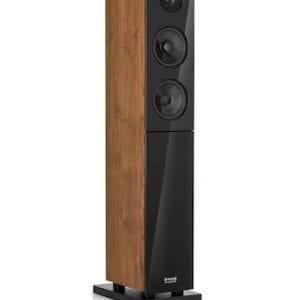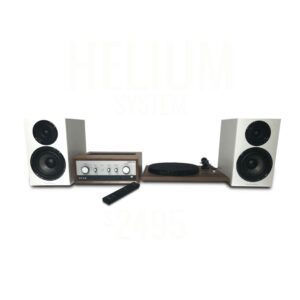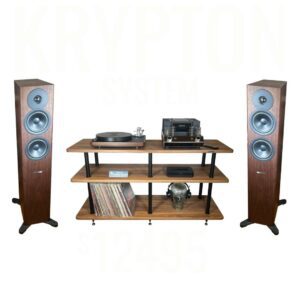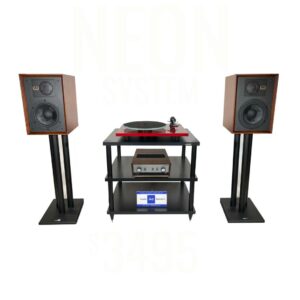[vc_row][vc_column][vc_column_text css=”.vc_custom_1535496054557{margin-bottom: 0px !important;}”]
Written by John Stancavage and published in the spring/summer 2018 edition of Part-Time Audiophile’s The Occasional

I was checking my email recently when I noticed a breathless announcement from Best Buy that “AUDIOFEST IS HERE,” with “Incredible Savings on Amazing Sound.”
OK, worth a look, I thought as I clicked on the message. Many Best Buy stores include a Magnolia outlet, which routinely stocks high-end brands such as MartinLogan, Sonus Faber, McIntosh, Sennheiser, and AudioQuest.
As I scrolled down, though, the first item promoed (with a photo) was a TV soundbar. The second was a Bose Wave radio and then a Sonos wireless speaker. Farther down was a Google Home Max voice-response speaker.
Almost lost amongst all these “lifestyle” gadgets was a small photo of an inexpensive Denon receiver next to a budget Audio-Technica turntable. Still, they were the closest thing to traditional audio in the ad. The high-end names I mentioned above might have been included in AudioFest had you walked into the store looking for them, but Best Buy wasn’t expending any space in this particular ad to promote them.
To be fair, Magnolia did follow up with its own ad. The first item? A Pioneer Elite “smart speaker” with Alexa.
It struck me that this is the stark reality of hi-fi as a mainstream hobby in 2018. The electronics most people think of for playing music — if they are not using cheap earbuds or even their phone’s miniscule speaker — are, at most, monophonic wi-fi boxes or the dreaded soundbars. It seems that proudly installing in your home a system made up of a separate amp/preamp or receiver and a pair of traditional speakers has faded into the past with other quaint pastimes such as raking your shag carpet and developing film.
At every audio show I’ve attended in the past decade, at least a couple of people will bring up the same question as they scan the sea of gray hair: “How do we get more young people into our hobby?”
With a few exceptions, hi-fi today remains rooted in the component-system strategy of decades past. When I was a teenager in the 1970s, this was alluring because such rigs were everywhere. There were the “stereo shops” where you could ogle the good stuff like Marantz electronics, Thorens turntables and KLH speakers. Everywhere else, though — department stores, appliance outlets and even furniture retailers — you would see some type of two-channel (or, for a fleeting couple of years, four-channel) setup for sale. Typically, these were cheap Japanese brands with a lot of flashing lights but poor sound quality.
Still, for kids like me, even the most sketchy systems became the primary goal of income from a paper route or summer of mowing lawns. After buying a stereo, earnings and weekly allowances went toward one album a week, after a long search through the record store, studying covers and listening to what the weird guy behind the counter was playing.
At some point, you discovered that some stereos sounded better than others — a lot better. For me, it was when a friend of my parents bought a pair of huge Bozak speakers. I reclined on the carpet in front of them all evening, mesmerized.
“Can we get those?” I asked my mother. “No,” she replied. “Why not?” I pushed, with her explaining they were much too expensive. “But he works at the same company Dad does,” I continued, even then not wanting to lose a disagreement. “Yes, but he’s a bachelor,” my mom countered, firmly shutting down my hi-fi dreams for the moment.
Today, many of us AARP audiophiles with similar childhoods wonder aloud why there’s not a similar fervor among the current younger generation about better sound. The thing that occupied many of our waking hours seems to have been usurped in part by time spent on social media and gaming, with music listening primarily taking place through earbuds and single Bluetooth speakers.
“If these kids could just hear good two-channel — even the entry level,” we say.
Therein lies the challenge, though. Stereos no longer are everywhere. Smart boxes are. Even veteran audiophiles have to expend considerable effort these days to find and audition the newest gear. What chance does a newbie have? Many of the traditional access ramps into the hobby closed quite a while ago.
“Wait a minute,” we say. “Isn’t this younger age group buying vinyl — our format?” Yes, some younger listeners do like wax, but that doesn’t mean all of them are going full-on VPI. Many of these hipsters are using portable, speaker-included players that sell for as low as $39.99 at Target, while others just admire the album art and use a download code to put the music on their phone as low-rez MP3s.
So, does all of this portend a bleak future for hi-fi, especially as baby boomers age out? Not necessarily. A lot of people who make their living in the industry remain optimistic. And some are particularly focused on attracting tomorrow’s music lovers. It can be done, they say.
One is Paul McGowan, who co-founded Boulder, Colorado-based PS Audio in 1973. The company makes hi-fi staples such as amplifiers, preamps, digital converters, power products and cables, along with embracing newer technologies such as streaming players and music-management software.
First off, he strongly rejects the theory that younger people don’t care about good sound.
“I’ve been hearing this same concern for 45 years,” McGowan told me in a telephone interview. “It’s nothing new. I didn’t believe it then and I don’t believe it now.”
Today’s listeners have access to more music than ever before, he said, with streaming services such as Spotify, satellite and Internet radio, download stores such as iTunes and web locations including YouTube, as well as traditional physical media like CDs and LPs. Eventually, they’ll want to hear their favorite songs in higher fidelity, he argued.
“Music still is a big part of people’s lives. When they get to age 25 to 35 and beyond concerns about food and rent, they’ll look for something better in what they consider necessities — cars, houses, and stereos,” McGowan said.
While PS Audio offers some equipment with price tags that can go into five figures, McGowan and his team realize a first-time buyer likely will start more modestly.
To address that, six years ago McGowan put his son, Scott, in charge of developing an entry-level component. After 24 months of work, Scott delivered the Sprout, a $500 integrated amp that features an exterior of polished aluminum and walnut and an interior containing high-quality parts. To befit the youth-oriented nature of the Sprout, it was marketed with a Kickstarter campaign. The unit recently was upgraded to the Sprout 100, with the price rising to a still-economical $600.
The company has taken current trends into account with other equipment as well. For instance, when developing its recent Bridge II DAC upgrade, McGowan decided to include Spotify Connect so listeners could easily use the popular — but somewhat lower-rez — streaming service.
McGowan said he uses Spotify himself, mainly for background music or to discover new tunes. He decided it had a place in a high-end component after overhearing an audiophile society member quietly admit a love of the service.
“That was an aha! moment for me. Most of us are focused listeners at times, but much of our listening is more casual than critical. And this is where the beauty of a streaming service like Spotify comes in.”
Aside from that effort, PS Audio also has embraced social media, with the elder McGowan offering a blog, podcast and YouTube videos. The company’s website also is designed for easy ordering.
While manufacturers are evolving with the times, retailers are making changes as well. Much has been written about the decline of brick-and-mortar audio shops, but, truth be told, the entire retail industry has been disrupted by Internet commerce. Some audio sellers, though, may have hastened their woes by jumping into the home-theater business — where margins were tight — and cutting back on two-channel lines and service.
Many of the stereo retailers still operating today are smarter about appealing to their niche. That includes attracting younger listeners. One shop that seems to be succeeding with such a focus is Audio Element in Pasadena, California.
Audio Element is owned by Brian Berdan, himself still a young person in his 30s. He began his hi-fi sales career working for his father Brooks Berdan at a shop in Monrovia carrying that name. After his father died, Brian left the store and went out on his own. Rather than opt for cheaper space off the beaten path, as some retailers have done, he chose a thriving entertainment district in Pasadena on Union Street, where there’s plenty of foot traffic and eyeballs looking through the window.
Passers-by glancing in see a half-dozen turntables positioned in the front room. The youth-friendly eye candy is intentional, as are some of the selections that might be playing. The day I visited, it was AC/DC’s “Back in Black.” There’s no audiophile snobbery at Berdan’s shop.
“The turntables help create the atmosphere we want,” Berdan said. “They definitely pull people into the store. There’s a nostalgia factor for physical objects.”
At the same time, he is keenly aware that many of his clients access music in different ways. Berdan said his job is to show them how to make it sound better.
The store owner uses social media to promote his business and also does things like hold listening parties where guests can bring their own records. In addition, he aggressively pursues Yelp consumer-recommendation ratings. “That’s the way a lot of 20- and 30-somethings find out where to go,” he said.
Berdan caters to veteran hobbyists just as intensely. He is a frequent audio show exhibitor, often outfitting his room with such upscale brands as Wilson Audio loudspeakers and VTL electronics, which he also demos in a custom-designed space in his store.
While Berdan is luring new listeners with turntables, an upstart Boston-area company is finding success by making them. U-Turn Audio launched its Orbit turntable through a Kickstarter campaign in 2012. The business quickly has carved a place in the manufacturing of sturdy plug-and-play models, with most selling for $179 to $459, including cartridge. Today, U-Turn has sold 50,000 Orbits, primarily by appealing to young buyers.
“For a lot of the folks we sell to, the Orbit is their first experience with vinyl and their introduction to two-channel stereo,” said Ben Carter, the company’s co-founder. “Our niche is to offer well-built turntables that get all the fundamentals of good playback right. Along with people new to vinyl, we attract those who bought a cheap discount-store player and now want something better.”
Carter and his partners may have an edge in understanding today’s youth market since they all are in their 20s themselves. He acknowledges young people like digital sources but contends they are attracted to physical media as well.
“A lot of them grew up with component stereos in the house, so they know what they are,” he said. “There’s a nostalgia factor.”
Many young people are becoming serious record collectors, he said. “They like the limited editions, the colored vinyl, imports,” Carter said. “We have customers who tell us they started buying albums even before they got their first turntable.”
Carter said the company embraces digital media such as Facebook, Instagram, and Twitter to market its products. Its website also contains a lot of easy-to-read tips about spinning vinyl and putting together a two-channel system.
“Component systems can be intimidating,” Carter said. “A lot of our buyers, for example, don’t know what a phono preamp is or why they need one. It’s things like that, I think, that can scare new people off from the audiophile world. As an industry, all of us can do a better job educating people and making things easier for the user.”
U-Turn keeps things simple by offering a limited number of options. It also sells Audioengine self-powered speakers on its website, so with a few clicks a buyer can have everything he or she needs to play music for as little as $500.
Carter said he is optimistic the vinyl trend hasn’t peaked and believes younger people will continue to discover the pleasures of hi-fi sound. “Vinyl sales still are growing,” he observed. “Album prices are starting to come down a bit as more pressing plants open, which should help.”
U-Turn is a frequent exhibitor at audio shows, where organizers have stepped up efforts in recent years to draw in the hi-fi curious. Along with setting up entry-level rooms, one of the fast-growing segments at shows is the headphone area. That’s where the youngest crowd usually can be found, trying out the alternatives to mass-market “cans.”
Bill Kanner, a public relations executive who has spent decades in the high-end industry, said it is critical for shows to highlight more than the $100K systems. At the 2017 Los Angeles Audio Show, Kanner helped promote an “audio for the rest of us” room, which featured entry-level gear. The times I visited, lines were backed up outside into the hallway.
The show also partnered with a local radio station and gave out tickets to area college music students. Other stereo shows, such as the recent Audio Expo North America in Chicago, offer similar budget rooms and youth discounts.
“For the audio industry to thrive, we have to reach out beyond audiophiles,” Kanner told me. “I’m 74 years old and I want this hobby to go on beyond my generation. Music makes life beautiful.”
So, while the hi-fi world has faced some serious disruption in recent years, its future does not appear as cloudy as some observers frequently worry.
Perhaps one of the biggest drivers may be that listening to albums on a good stereo encourages social interaction, which especially appeals to a younger generation that spends a lot of time on their mobile devices.
“If they are on the go, yes, they are going to be listening to their phones, but if they are hanging out together they will want to play albums,” U-Turn’s Carter said. “They can pass the jackets around, look at them and talk about the music. It’s more fun.”
[/vc_column_text][/vc_column][/vc_row]





